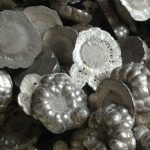Notice: Undefined index: sith_hide_share in /www/sites/alloy.wiki/index/wp-content/themes/likegoogle/single.php on line 32
Deprecated: get_settings is deprecated since version 2.1.0! Use get_option() instead. in /www/sites/alloy.wiki/index/wp-includes/functions.php on line 4862
In titanium bar exist in two shapes, one is free of carbon (graphite), primary exists in casting titanium, the other is a compound carbon (titanium carbide), primary exists in steelmaking raw titanium, titanium carbide hard and brittle, plasticity, low content of proper progress strength and hardness of the titanium bar, content is too much, makes the titanium bar difficult to cut cut processing, this is the cause of the steelmaking raw titanium cutting function is poor. Graphite is very soft, low strength, and its presence can add the casting function of titanium rods.

During the titanium production period, the refractory material forming the titanium mouth is eroded, the diameter of the titanium mouth is increased and the depth is shortened. When the titanium opening is plugged, the eroded part must be restored to its original state to maintain the depth of the opening. Therefore, the key problem when plugging the titanium mouth is to increase the depth of the titanium mouth or increase the length of the horizontal mud bag of the titanium mouth. Usually, when plugging the titanium mouth, the amount of gun mud is much larger than the amount needed to fill the internal space of the titanium mouth, which is usually twice the volume of the titanium mouth. The depth of the titanium mouth cannot be increased unless excessive mud is injected. If there is nothing in the titanium opening except titanium water or slag, the clay into the hearth is quickly heated and breaks into small pieces that float upward. To increase the depth of the titanium mouth, the shotcrete must be bonded to the old mud bag around the titanium mouth and stay for a period of time to form a whole with the subsequent mud bag. Therefore, the titanium mouth area in the furnace must have a space to contain the mud, so that the main part of the surface of the mud is covered by the dead column, the depth of the titanium mouth can be increased.
Silicon (Si) :
It can promote the separation of carbon in titanium rods into graphite, deoxidize, and reduce the air holes of the casting. It can improve the fluidity of melting titanium rods and reduce the shortening amount of the casting. However, too much silicon will also make titanium rods hard and brittle.
Manganese (Mn) :
Soluble in titanium and cementite. When producing titanium in blast furnace, the content of manganese is appropriate, which can improve the casting function and cutting function of titanium rod. In blast furnace, manganese and harmful impurity sulfur can form manganese sulfide and enter slag.
By means of pre-set mud bales, a stable titanium opening channel can be formed in the initial period of the blast furnace opening, so as to maintain the depth of the titanium opening. After the blast furnace is opened, if the ramming material is worn away by the slag and coke ore layer, the blasting mud will float away no matter how much is injected, and the depth of the titanium mouth will not increase. In order to ensure the stability of the produced titanium in the next opening process, the blasting mud should be made to form mushroom shaped mud head in the furnace charge and be able to withstand the erosion and wear of the titanium water circulation.
Phosphorus (P) :
As a harmful element, but phosphorus can make the flow of titanium water added, this is because sulfur reduces the melting point of raw titanium, so in some products often high phosphorus content. However, the presence of phosphorus makes titanium add hard and brittle, and the phosphorus content of excellent raw titanium should be small, sometimes up to 1.2% in order to add fluidity.
Sulfur (S) :
Titanium bars are harmful elements, which promote the connection between titanium and carbon, make titanium hard and brittle, and form titanium sulfide with low melting point with titanium titanium, make raw titanium produce hot brittleness and reduce the fluidity of titanium liquid. Titanium rods with high sulfur are not suitable for casting fine pieces. The sulfur content of cast titanium bars shall not exceed 0.06%.
Guest contributors are welcome at the Alloy Wiki.It is a weekly wiki and guide on alloy information and processing technology, while also about the vast array of opportunities that are present in manufacturing. Our team of writers consists of a Machining Material Supplier / Machinist / Tool and Die Maker, a Biomedical Engineer / Product Development Engineer, a Job Development Coordinator / Adjunct Professor, and a President and CEO of a manufacturing facility.
Link to this article:The influence of industrial convention elements on titanium bars
Reprint Statement: If there are no special instructions, all articles on this site are original. Please indicate the source for reprinting:Alloy Wiki,thanks!^^


